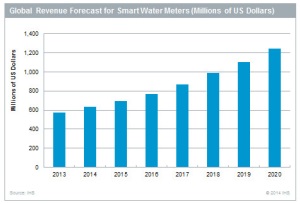
by Brianna Crandall — October 27, 2014—As the fastest-growing segment of the global water meter industry, the worldwide market for two-way smart meters is set to surpass the $1 billion mark for the first time in 2019, with managed services, analytics and smart water network adoption all combining to accelerate growth, according to a new report from IHS Technology.
The two-way smart water meter business was worth $575 million at the end of 2013. The market will expand to $1.1 billion in 2019, as shown in the figure on this page. By 2020, smart devices will make up 29 percent of total revenue for water meters, compared to 18 percent last year.
According to the report, North America continues to be the leading adopter of two-way water meters used in advanced metering infrastructure (AMI) networks, but stronger growth is occurring in Europe. France is the fastest-expanding market of all major countries worldwide, with smart meter penetration approaching the 50 percent mark. Following France in Europe are the U.K., Ireland and Germany—all countries experiencing a rapid transition to adopting two-way smart water meters.
Benefits of smart water meters
Digital in nature, smart meters do not introduce the element of human error into readings, notes IHS. This yields greater accuracy than traditional basic meters or one-way devices. Moreover, smart meters installed in homes or businesses can engage in two-way communications with electric utilities, letting the smart meter gather data and allowing for many emerging smart water network applications, from metering reading to leak detection, points out IHS.
“The benefits of installing smart water meters are growing, and installing this new technology is also becoming easier for utilities that previously haven’t been able to invest in smart meters,” says Michael Markides, associate director for smart utilities infrastructure at IHS. “Utilities that have the capability to purchase smart water meters now are considering implementing smart water networks. These networks will deliver a whole host of new functionality that can be achieved thanks to integrating modern information technology into their daily operations.”
Meanwhile, utilities that to date have not been able to justify upgrading their meters to an AMI network are being given new opportunities to do so, Markides notes. In such cases, vendors in the space are evolving their solutions toward the so-called managed services model, eliminating the initial need for capital outlays while offering much-needed expertise.
A new paradigm emerges
The smart water network is identical in concept to that of the smart electric grid—employing electronics, communications and software to facilitate real-time management of the distribution network, all with an eye toward increasing efficiency and reliability while also improving customer service, notes IHS.
According to the report, as AMI data increases in value, smart meters are upending traditional models of operation in favor of greater efficiency. While automating the meter-reading process is still a chief market driver for installing AMI, other applications can be improved with the use of AMI data. Leak detection, customer service, hydraulic monitoring and pressure testing, as well as many other tasks that a water utility must undertake, can now be done by maximizing use of the AMI data. These applications can be conducted more regularly, performed more quickly, and carried out with higher quality assurance.
These findings are available in the report entitled Water Meters Report – 2014, the main report for the Smart Water Meter Intelligence Service, from the Power and Energy service of IHS Technology.




